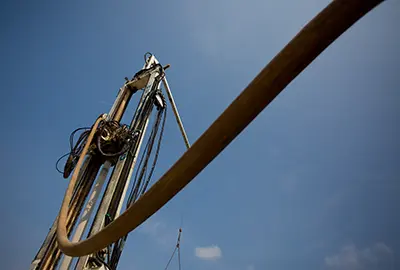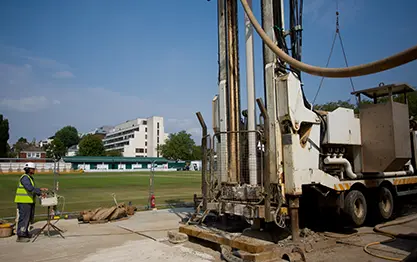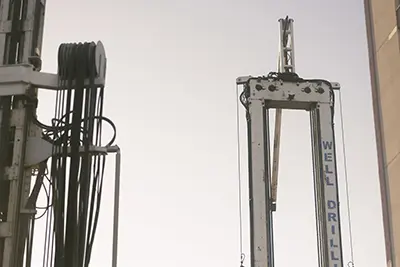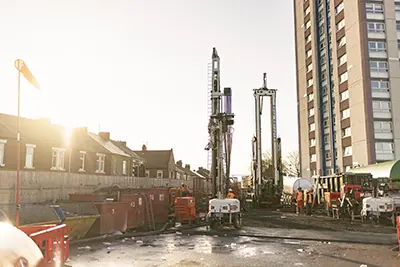

Geothermal
Utilising solar energy stored underground, Igne assists in creating geothermal energy solutions by drilling and installing boreholes in collaboration with designers and consultants.
INFORMED
Geothermal Prognosis
Prior to undertaking a geothermal project, a prognosis must take place to assess the ground’s capacity to deliver heat to a heat pump. A prognosis, or ‘geo-report’ generally looks at:
- Geology and ground compositions: the heat transfer capabilities of the ground will vary depending on factors such as soil types, rock formations, and thermal conductivity. It will also identify if there are any drilling hazards or obstructions on your site.
- Ground temperature profile: what is the subsurface temperature at different depths? Higher temperature gradients equals more efficient ground source heating systems.
- Groundwater availability: the depth, volume, flow and quality of groundwater will affect the impact of the ground source heat pump.
- Layout: depending on factors such as the available land area and soil conditions, the layout and length of the system will differ: e.g. horizontal or vertical loop boreholes.
Igne’s geo-reports utilise data from maps, national archives, and databases: all of which are interpreted by a chartered geologist.
COST EFFECTIVE
Ground Source Heat Pumps
Igne’s ground source heat pumps can return energy at a 1kW:4kW ratio, making it an extremely cost-effective method of heating or cooling.
If the prognosis report identifies the correct conditions for ground source heating, Igne will install a heat collection system which is necessary for the ground source heat pump to operate.
The pump will then extract heat from the ground and transfer it to an above-ground building for space and water heating.
Heat can be returned to the ground to cool the building during periods of hot weather.
HORIZONTAL OR VERTICAL
Heat Collection Systems
There are two main types of heat collection systems: horizontal and vertical.
Horizontal heat collection systems involve digging at least 10m of trenches (at a depth of 2m) for each kWh gained. This method of heat collection is expensive and is not recommended by Igne.
Instead, Igne recommends using a vertical heat collection system. Vertical systems are simpler, faster, and more cost-effective, requiring boreholes to be drilled rather than trenches. Additionally, boreholes are much less disruptive to your site and offer better consistency and efficiency in heating.
There are two types of vertical heat collection systems:
- Closed loop: these utilise U-shaped pipes with anti-freeze and a heat-conductive grout. The water is circulated through the pipes, to your building, and is subsequently returned to the ground.
- Open loop: water is collected from the ground and is circulated directly through the heat exchanger/pump system, and can then either be used as a grey-water supply, be discharged to a surface water system, or be routed back underground.
Igne has extensive experience installing both open and closed-loop vertical systems, and has worked with major clients such as city councils and leisure centres. To learn more about what system is right for you, contact Igne’s team of experts today.
BENEFITS
Why ground source heating?
Ground source heating systems have numerous benefits, including…
- Cost-effectiveness: ground source heating outputs 4x the amount of energy it uses, meaning its coefficients of performance (COP) value is extremely high. This can significantly reduce your heating bills.
- Sustainability: ground source heating reduces CO2 emissions by utilising the stable temperature of the earth as a heat source. This is a sustainable and renewable energy source which leads to a cleaner and greener environment.
- Consistency: ground temperature remains relatively stable throughout the year and are typically unaffected by weather and external factors such as outdoor air temperatures.
- Lifespan: ground source heating systems have a long lifespan (up to several decades) and require minimal maintenance. Heat pumps, when properly maintained, can have a lifespan of 25 years or more.
To receive a geothermal prognosis, or to receive an obligation-free consultation with Igne, contact our team of experts today.


Open Loop Geothermal

Closed Loop

Minewater Geothermal Boreholes
For more information about geothermal energy solutions, contact Igne today
Email: hello@igne.comCall: 0371 789 1000
